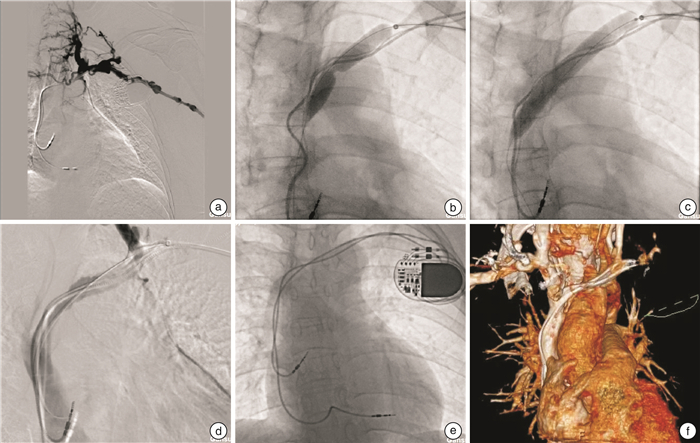One case of superior vena cava occlusion syndrome and pacemaker malfunction associated with leads
-
摘要: 永久性人工心脏起搏器植入术后并发上腔静脉阻塞病例虽有报道,但慢性闭塞同时合并起搏功能障碍案例极少。本例患者在植入双腔心脏起搏器术后4年,出现上腔静脉阻塞综合征表现,且起搏器程控发现心室电极起搏阈值升高至3.5 V仍有间歇性心室失夺获。肘正中静脉造影提示左锁骨下静脉至上腔静脉段完全闭塞,侧支循环丰富。本病例采用介入球囊扩张技术,开通闭塞血管段,徒手拔除原心室电极,同侧植入新心室电极。术后起搏器功能正常,临床症状缓解,治疗效果理想。Abstract: Superior vena cava (SVC) occlusion has been reported after permanent pacemaker implantation, but chronic occlusion combined with pacing dysfunction is rare. The patient occurred SVC obstruction syndrome 4 years after implantation of a double-chamber pacemaker, and the pacing threshold of the ventricular electrode was increased according to the pacemaker programming. Median cubital venography showed complete occlusion of the left subclavian vein with abundant collateral circulation. In this case, we used the interventional balloon dilation technique to recover the occluded vessel segment, remove the original ventricular electrode by hand, and implant the new ventricular electrode. Eventually, we successfully treat this patent and relieve the symptoms of SVC.
-
Key words:
- cardiac pacemaker /
- subclavian vein /
- superior vena cava syndrome /
- balloon dilation
-

-
[1] Clémenty N, Fernandes J, Carion PL, et al. Pacemaker complications and costs: a nationwide economic study[J]. J Med Econ, 2019, 22(11): 1171-1178. doi: 10.1080/13696998.2019.1652186
[2] Azizi AH, Shafi I, Shah N, et al. Superior vena cava syndrome[J]. J Am Coll Cardiol Intv, 2020, 13(24): 2896-2910. doi: 10.1016/j.jcin.2020.08.038
[3] Cacko A, Kozyra-Pydys E, Gawałko M, et al. Predictors of venous stenosis or occlusion following first transvenous cardiac device implantation: prospective observational study[J]. J Vasc Access. 2019, 20(5): 495-500. doi: 10.1177/1129729818815135
[4] Arora Y, Carrillo RG. Lead-related superior vena cava syndrome: Management and outcomes[J]. Heart Rhythm, 2021, 18(2): 207-214. doi: 10.1016/j.hrthm.2020.09.006
[5] Gabriels J, Chang D, Maytin M, et al. Percutaneous management of superior vena cava syndrome in patients with cardiovascular implantable electronic devices[J]. Heart Rhythm, 2021, 18(3): 392-398. doi: 10.1016/j.hrthm.2020.11.012
[6] Safi M, Akbarzadeh MA, Azinfar A, et al. Upper extremity deep venous thrombosis and stenosis after implantation of pacemakers and defibrillators: a prospective study[J]. Rom J Intern Med. 2017, 55(3): 139-144.
[7] 李赐恩, 宋卫锋, 王徐乐等. 起搏器感染后再次植入原起搏器和植入新起搏器的安全性比较分析[J]. 临床心血管病杂志, 2017, 33(4): 353-355. https://www.cnki.com.cn/Article/CJFDTOTAL-LCXB201704014.htm
[8] 高洁, 李洪仕, 朱可佳, 等. 安装心律植入装置术后静脉阻塞的发生率及危险因素分析[J]. 中国循环杂志, 2020, 35(6): 599-603. https://www.cnki.com.cn/Article/CJFDTOTAL-ZGXH202006016.htm
[9] 张建军. 永久性起搏器植入围手术期需要考虑的细节及技术要点[J]. 临床心血管病杂志, 2021, 37(11): 975-978. https://www.cnki.com.cn/Article/CJFDTOTAL-LCXB202111001.htm
[10] Vaile JR, Rame JE, Alvarez RJ, et al. 3 Cases of Superior Vena Cava Syndrome Following Percutaneous Right Ventricular Assist Device Placement[J]. JACC Case Rep, 2021, 3(15): 1690-1693. doi: 10.1016/j.jaccas.2021.09.005
[11] 党升强, 毕军刚. 采用介入方法治疗恶性肿瘤所致上腔静脉阻塞综合征[J]. 血栓与止血学, 2021, 27(4): 630-631. https://www.cnki.com.cn/Article/CJFDTOTAL-XSZX202104038.htm
-





 下载:
下载: